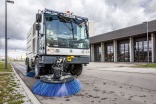Home › magazine › november 2023 › latest news › Big event sweeping
Big event sweeping
30th of January 2024How difficult is the task of sweeping up after a major indoor or outdoor event? What challenges do such occasions pose, and what types of machines are geared up for these particularly tough tasks? Ann Laffeaty asks sweeper manufacturers for their insights.
THE WORST OF THE pandemic is behind us which means that large events are back – and there have been plenty of them being staged this year. The King’s coronation drew in huge crowds in London in May, for example, while the FIFA Women’s Football World Cup in Australia and New Zealand attracted record crowds in July.
Back in the UK, this year’s Glastonbury Festival and the Notting Hill Street Carnival were both very well attended. And the Rugby World Cup was played to packed stadiums across France during September and October.
These types of occasions inevitably put enormous pressure on the clean-up teams tasked with removing every last scrap of debris from the spaces occupied by the event.
For example, an estimated 2,000 tonnes of waste – equating to nearly 10 kilogrammes per visitor - was left behind after the Glastonbury festival in June with items needing to be removed including tents, plastic bags, laughing gas canisters and food containers.
Later in the summer, council workers were expected to clear away 300 tonnes of rubbish - equivalent to the weight of 25 double-decker buses – from London’s streets following the two-day Notting Hill Carnival. Some 200 cleaners and 30 refuse trucks were involved in the huge clean-up operation in which many thousands of plastic bottles, takeaway containers and nitrous oxide canisters had to be removed.
Logistical challenge
But what are the specific sweeping challenges that such occasions pose? Does the type of debris and the access arrangements make life particularly difficult for the clean-up teams? Or is the main challenge the sheer amount of debris to be cleared up?
Sweeping up after a large event can be a significant logistical challenge according to Chiara Molardi, marketing specialist at IPC by Tennant Company. “There are several reasons for this,” she said. “The type of waste and debris that needs to be cleaned away can vary greatly depending on the event. People attending a music festival, for example, may leave behind items such as drink cans, food wrappers and even hazardous materials such as lighters.
“Large events may also have limited access points, making it difficult for sweeping equipment and personnel to get through. And the huge amount of debris generated by a big festival can overwhelm the cleaning teams, especially if the occasion lasts more than a day and attracts thousands of participants.”
Safety protocols
Handling hazardous waste requires specialist training and bespoke equipment, she adds. “Operators need to follow safety protocols, wear appropriate protective clothing and use special containers to dispose of hazardous materials,” she explained. “It is crucial to prioritise safety when dealing with this type of waste.”
The choice of sweeper will depend on the specific needs and challenges of the event in question, says Molardi. “However, there are some key characteristics that will be required of any machine tasked with a big event clean-up,” she adds.
Sweepers will need to offer a large capacity and be efficient, manoeuvrable and durable, she says. “A sweeper with a substantial waste-holding capacity will be essential for events that generate a high volume of debris because this will reduce the frequency of emptying while also improving efficiency,” she said. “All equipment will also need to be robust and durable in order to withstand prolonged use in challenging conditions. It should be able to handle various terrains and operate in all weather conditions, too.
“And the sweeper operator needs their machine to be easy to manoeuvre, particularly in tight spaces and crowded venues.” High-efficiency sweepers will enable the operator to cover large areas quickly, she says – and this is crucial in the case of events with tight schedules and limited access points.
“There may also be environmental considerations to bear in mind since some organisers may prioritise eco-friendly sweepers with low emissions and reduced environmental impact,” she said. “And safety is paramount, which means sweepers should have features that protect the operator and the public such as back-up alarms, visibility enhancements and safety systems.”
Location and type of event
IPC by Tennant Company offers various ride-on sweepers that can be deployed after a big event including the 175 and 195 industrial sweepers and the 1404 and 1280 models. The 1280 sweeper may be used both outdoors and indoors and is available with battery power, diesel/petrol engine or in a dual power petrol hybrid version. The battery model is said to provide up to four hours’ operating time and is described as being simple and intuitive to manoeuvre.
The logistical challenge of cleaning up after a big occasion depends on the location and type of event in question, says Kärcher Municipal’s product management director Matthias Fleig.
“These parameters will have an influence on factors such as the ground condition, floor coverings, accessibility and the extent of soiling, waste and debris,” he said. “And these in turn will determine which technologies or models will be most suited to the task since different sweepers will be required in different areas.”
Floor cleaning serves several purposes after a large event, says Fleig. “For example it will help to reduce the risk of accidents while also preserving the floor covering and helping to prevent secondary contamination,” he said. “The type and size of debris plays a definite role in the sweeping challenge, as does the type of surface on which the event is held. These factors can determine which machine and what kind of cleaning tools to use, and what material the brushes should be made of.”
Machinery a problem
Larger machines can be used for sweeping up after events in indoor spaces or even in large outside areas that have a stable and even surface, he says. “However, an outdoor festival taking place on a grass surface that turns muddy - due to a lot of rain for example – can turn the use of machinery into a huge problem,” he said.
Most debris can be cleared away safely, even if the waste concerned is potentially hazardous, he adds. “In a normal situation the sweeper operator will have no direct contact with the waste itself because this will be collected either mechanically or through a suction system and then put in the big waste container,” he said. “Likewise, during the emptying process there will be no physical contact with the collected waste. However if the operator needs to manually pick up an item such
as a used syringe he or she would have to be cautious.”
Walk-behind battery-powered machines work well in medium to large-sized indoor areas, he says. “The fact these produce no exhaust emissions means they are ideal for cleaning indoor spaces, especially on hard surfaces such as coated and uncoated concrete subfloors,” he said. “They also work well on textile floor coverings and are available with an electric motor.”
Fleig recommends the use of walk-behind vacuum sweepers with a traction drive plus extraction and filter systems for medium-sized outdoor areas of up to 1,000 square metres in size.
“For larger outdoor areas spanning 1,500 square metres and above we advocate the use of ride-on vacuum sweepers because these will guarantee fatigue-free work,” he said. “They also have a large container volume and some of them come with a hydraulic high container for easy emptying.”
Municipal suction sweepers and mechanical sweepers both use brushes to sweep up the dirt and transport it into a large, sturdy waste container, he said. “These machines offer different brush options to increase their working width and can be used to quickly clean up larger areas,” he said.
Fastest results
The fastest cleaning results can be achieved using a mechanical sweeper because this has the highest working speed, he says. “However, depending on the layout of the area, the more agile suction sweepers can also be a good choice,” he adds. “These machines can be driven to a container where they can empty their contents quickly, and then continue cleaning again straight away.”
He says Karcher’s MC 50, MC 80, MC 130 and MC 250 suction sweepers and the MCM 600 mechanical sweeper can all be used for cleaning up after a major event. “In addition we also offer a complete range of commercial sweepers starting from small mechanical walk-behind machines to industrial ride-on models,” he said.
So, what type of clean-up operations create the biggest headache for sweeper operators and why?
“Open air festivals – such as the Wacken Open Air heavy metal festival in August - come to mind,” said Fleig. “These types of event are not always held on big asphalt areas but on soft grass, which can create more problems when sweeping up.
“If there is rain involved too, using a machine to clean the area afterwards can be even more problematic. But the main challenge at any event relates to the sheer amount of debris that will have been left behind by the revellers.”
IPC by Tennant Company’s Chiara Molardi agrees that music festivals tend to create the biggest clean-up headaches. “Here the waste will often need to be separated into recyclables, general
waste and potentially hazardous materials which adds complexity to the clean-up process,” she says.











